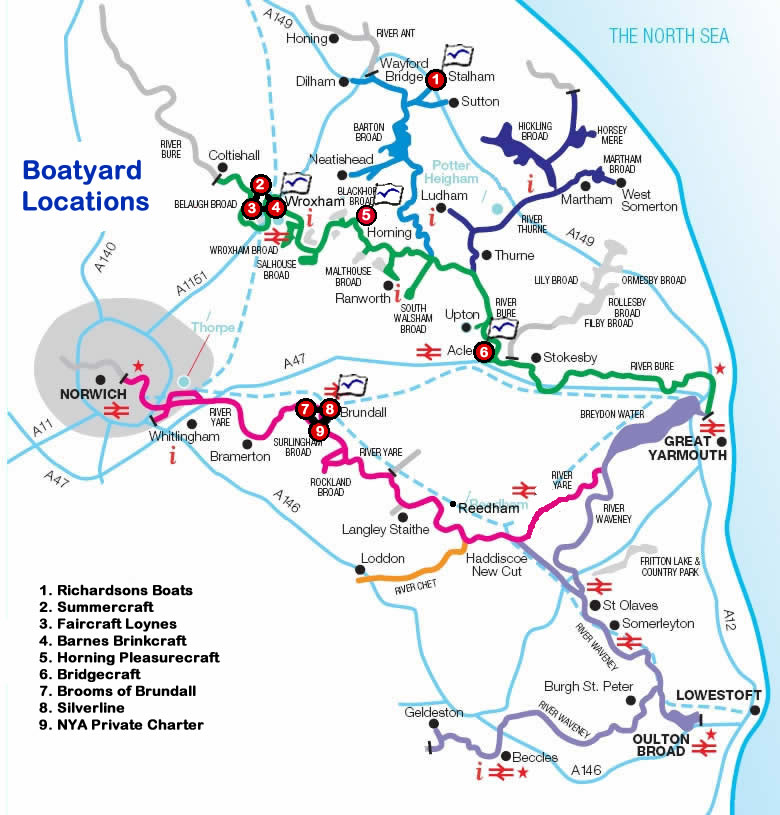

2023 Holidays
So perhaps you missed out on the boat you really wanted in 2022, and just want to be sure you get it in 2023. Or maybe you've just come home from a holiday on the Broads, and want to do it again next year. Many people have already booked for 2023, as you get the biggest choice by booking early. This page will help you find your ideal holiday.As there is likely to be a much greater choice of availability booking further in advance, (it really hots up from Christmas onwards) the advice is to use the first booking tool on the right (or below) of the page, where you can search for boats with the features that are important to you. A brief explanation of what some of them are follows below. If you're after a highly sought-after date, or just finding it difficult to come up with the exact boat for the dates you want, try using the second search box, which will display all boat availability.
Steers From
Norfolk Broads hire boats are set up to steer from either, the front of the boat (referred to as forward drive), from a middle raised section of the boat (called centre cockpit), and from the back section, (aft cockpit) In addition, you will see some boats referred to as "dual steer". These boats can be controlled from inside (usually where a centre cockpit would be), and outside on the top deck of the boat. They are very popular (and often the latest designs), as they afford al fresco cruising if the weather is good, or inside cover if it isn't. The final type to watch out for is referred to as "sedan steering". These boats will steer from the centre cockpit but will have a fixed roof above, rather than a sliding or collapsable canopy. This makes them popular in shoulder months, when the weather may not be as clement as in the summer. There's a more comprehensive guide to boat types HERE.
Northern or Southern Broads
The rivers that flow down to Great Yarmouth, The Bure, the Ant, and Thurne, are referred to as The Northern Broads. The rivers that flow into Great Yarmouth from the south, the Waveney, The Yare, and The Chet, are referred to as The Southern Broads. Most boatyard starting points are situated on the Northern Broads (see the map below), which is known to be less tidal and therefore easier for novices or those less able-bodied. It also has more to see, especially if you're looking for a 3 or 4-night holiday. Generally, an hour's cruise in the north will bring you to a new village or town. In the south, that's more likely to be 2 hours. There's still plenty to see in the south, but the tidal flow makes it trickier, and probably somewhere you would choose as your second holiday on the Broads.
Standard of boat
As a rough guide, consider a "budget boat" to be an equivalent of a 1 or 2-star hotel. "Standard" would be around a 3-star property and "Superior" might be what you would expect in 4 or 5-star accommodation. Having said that, please remember these are boats, and as such, what the boatyards can build into them, is going to be more limited than you would find in an equivalent land property. Please also read the "guidance" keyed from the features box on the right.
240v System
All boat electricity comes from the 12-volt battery system, which is charged up as you cruise along - much like a car charges its battery as you drive. The batteries operate domestic appliances such as TVs, refrigerators, lighting, and power the water pressure for hot and cold taps. A boat with 240 volts (240v) will have standard home-type 3 pin sockets and will power low-wattage items, such as microwaves, hair dryers, and games consoles, as well as provide power for charging cameras, phones, and laptops, etc. You can usually still charge phones etc, on boats without 240v, by utilising the "cigar lighter" socket that's available on most boats.
Bow Thrusters
All boats have a propeller, which is located at the stern (back) of the boat. This drives the boat through the water. In some locations, it can be desirable to have propellers at the bow (front) of the boat, which makes it more maneuverable in tight spaces. Bow thrusters are little propellers placed on either side of the hull under the waterline, towards the front of the boat. You control them from switches in the cockpit, using them to swing the bow either right or left. Because they allow much more control, they are very useful to those with little previous experience, and those who are less able-bodied, when mooring. They are, however, a refinement, and as such you only usually see them on more modern, and therefore more expensive hirecraft. They can be considered a luxury rather than a necessity, especially if your party consists of a few able bodies crew.




